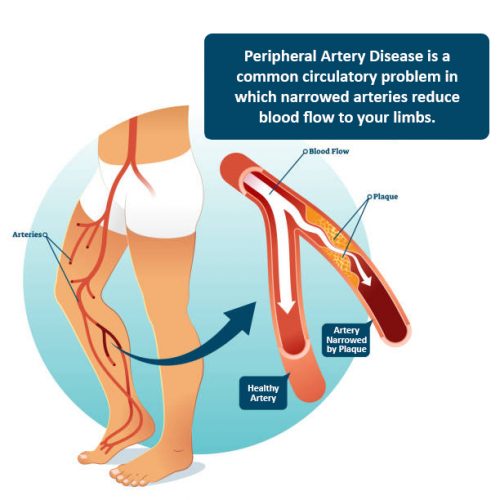Peripheral Artery Disease (PAD)
 The circulatory system is made up of a complicated network of arteries and veins that carry oxygen and nourishment through the blood to every part of the body. Peripheral vascular disease (PVD) occurs when there is a problem within the veins and arteries. Arteries are what supply oxygen and nutrients from the heart to the rest of the body. If an artery becomes blocked, known as peripheral artery disease, and can no longer delivery blood to other areas of the body, such as the foot and lower leg, serious problems can occur.
The circulatory system is made up of a complicated network of arteries and veins that carry oxygen and nourishment through the blood to every part of the body. Peripheral vascular disease (PVD) occurs when there is a problem within the veins and arteries. Arteries are what supply oxygen and nutrients from the heart to the rest of the body. If an artery becomes blocked, known as peripheral artery disease, and can no longer delivery blood to other areas of the body, such as the foot and lower leg, serious problems can occur.
Cause of Peripheral Artery Disease
PAD is typically caused by atherosclerosis- a buildup of plaque that eventually blocks the arteries. While most people know that poor diet and lifestyle choices can cause a buildup of plaque in arteries that supply heart and brain, many people don’t know that this same plaque buildup can also occur in blood vessels in your legs.
Diagnosing PAD
PAD is commonly diagnosed in one of two ways: an Ankle Brachial Index or Angiography.
Ankle Brachial Index: This test compares the blood pressure in your ankle of the suspected leg with the blood pressure in your arm. A significant difference in the two pressures might indicate a blockage exists somewhere in the leg.
Angiography: For this test, the doctor uses x-ray and dye injected through an IV to examine blood flow and look for blockages.
The Importance of Early Diagnosis and Treatment
The best treatment for PAD is prevention with healthy habits and a healthy diet. Quitting smoking will significantly reduce the risk of developing PAD.
Removing or lessening plaque buildup is the primary treatment. Untreated PAD can eventually lead to wounds that do not heal, resulting in tissue death (gangrene) and the possible need for amputation – a condition called Critical Limb Ischemia.

